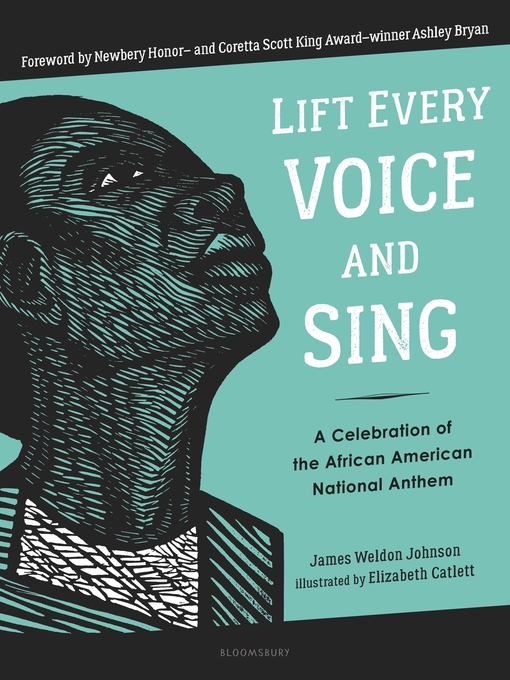- Available now
- New audiobook additions
- Most popular
- Audiobooks for the Whole Family
- Great Narrators
- See all audiobooks collections
-
Creators
-
Publisher
-
Release date
January 8, 2019 -
Formats
-
Kindle Book
-
OverDrive Read
- ISBN: 9781681199573
-
-
Languages
- English
-
Reviews
-
Publisher's Weekly
January 2, 1995
From the title page, on which clouds part to show the face of a weeping black woman whose tears splash into the sea, Gilchrist's (Nathaniel Talking; Night on Neighborhood Street) colored pencil, gouache and watercolor art is as emotion-charged as the lyrics of what is widely considered the African American national anthem. African American children and adults in contemporary clothing are portrayed alongside Africans in traditional dress; they appear against dramatic, sometimes foreboding backgrounds featuring such dynamic forces of nature as a stormy sea, swirling wind and the glowing moon. Gilchrist imports political and religious images (white-sheeted figures burning a bleeding cross, children soaring into the heavens) to convey both the song's sadness ("Stony the road we trod,/ Bitter the chast'ning rod'') as well as its ultimate hope ("Out from the gloomy past./ Till now we stand at last/ Where the white gleam of our bright star is cast"). The lyrics, written by African American statesman and educator Johnson (1871-1938), are reprinted together with the music scored by his brother, J. Rosamond Johnson, at the conclusion of this heady volume. All ages. -
Publisher's Weekly
February 1, 1993
Between the sober linocuts and the devotional text, this adaptation of what was once called the Negro National Anthem fairly effuses seriousness of purpose. Lyrics from a song written by two schoolteacher brothers in 1900 in honor of Abraham Lincoln's birthday caption prints created in 1946 and '47 by the granddaughter of slaves; the emphasis here is on suffering, deliverance and gratitude to God. A picture of the victim of a hanging, for example, faces ``We have come over a way that with tears has been watered / We have come, treading our path through the blood of the slaughtered.'' The score is provided at the end. Throughout, two-color art yields black-and-blue borders, while that blue, an almost turquoise tone, splashes through some of the linocuts. Much like ``The Star-Spangled Banner,'' the production of this anthem is big on reverence and short on spontaneity. All ages. -
Publisher's Weekly
January 1, 2001
In honor of this song's centennial anniversary, this volume collects 22 often stirring black-and-white archival photographs to illustrate Johnson's powerful lyrics, set to music by his brother, John Rosamond Johnson. Smith's rather spotty introduction offers a brief biographical sketch of the siblings and outlines the genesis of the song (though it is the back jacket flap that suggests that James W. Johnson was asked by the Florida high school where he served as principal to compose the song for a celebration of Abraham Lincoln's birthday). Two decades later, in 1920, the NAACP proclaimed the composition "The Negro National Anthem." Crisply reproduced photographs ranging from the sobering to the uplifting correspond to the words of the anthem. "Out from the gloomy past,/ Till now we stand at last/ Where the white gleam/ of our bright star is cast" shows an enchanting toddler girl in a white wool coat and matching hat holding hands with two adults among a crowd. A photograph of Martin Luther King Jr.'s "I Have a Dream" speech is paired with "Lest our feet stray from the places,/ Our God, where we met Thee.... " Other memorable shots include the scarred back of a captive man ("Stony the road we trod,/ Bitter the chastening rod"), an exhausted boy cotton-picker asleep in the fields and a girl learning to read. Unfortunately, though the photos are credited, they neither include the year nor the context in which they were taken. The melody line concludes the book, and the many children featured in the photographs will draw a young audience into this affecting volume. All ages.
-
subjects
Languages
- English
Loading
Why is availability limited?
×Availability can change throughout the month based on the library's budget. You can still place a hold on the title, and your hold will be automatically filled as soon as the title is available again.
The Kindle Book format for this title is not supported on:
×- - Kindle 1
- - Kindle 2
- - Kindle DX
- - Kindle Keyboard
- - Kindle 4
- - Kindle Touch
- - Kindle 5
- - Kindle Paperwhite
- - Kindle 7
- - Kindle Voyage
Read-along ebook
×The OverDrive Read format of this ebook has professional narration that plays while you read in your browser. Learn more here.

